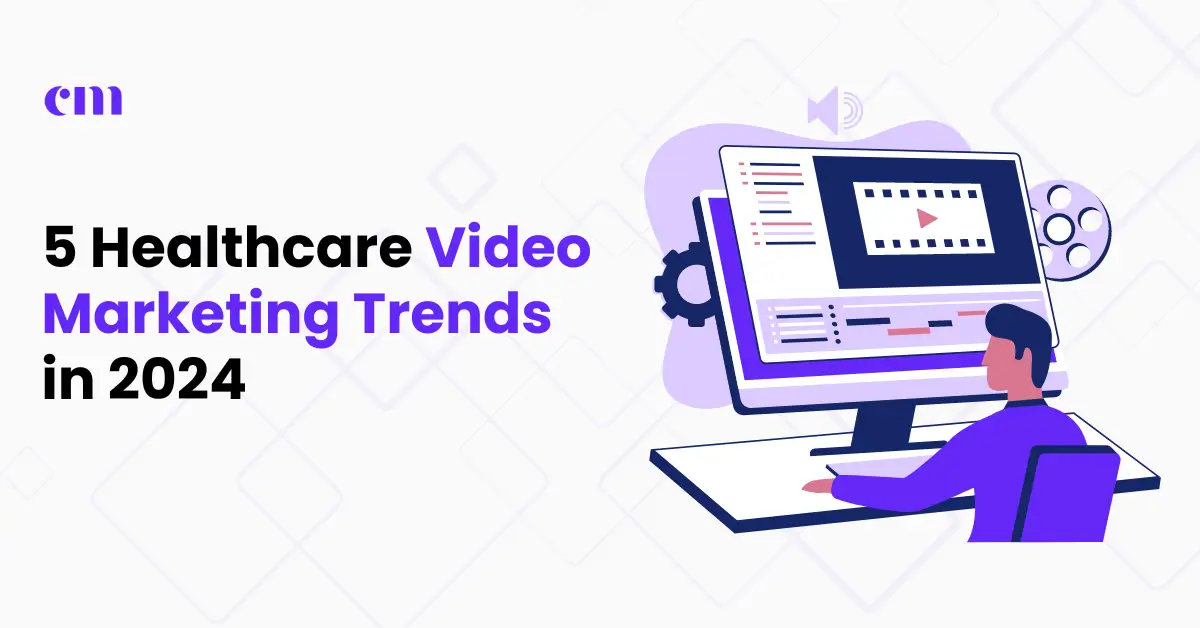In 2024, the medical industry is poised to leverage healthcare video marketing more than ever before.
Contents
ToggleAccording to Bluenovius, video content can increase patient engagement by up to 80%.
As digital transformation continues to reshape various sectors, healthcare organizations are increasingly recognizing the power of video content to engage patients, educate the public, and build trust.
Here are the top five video marketing trends that healthcare providers should watch out for in 2024.
Table of Contents:
- 5 Healthcare Video Marketing Trends in 2024
- Personalized Patient Experiences
- Live Streaming for Real-Time Engagement
- Short-Form Videos and Social Media Integration
- Virtual Reality (VR) and Augmented Reality (AR) in Patient Education
- User-Generated Content (UGC) and Community Building
- 5 Types of Videos for Healthcare Professionals
- 5 Ways to Discover the Latest Video Marketing Trends for Healthcare Professionals
- Conclusion
5 Healthcare Video Marketing Trends in 2024
Here are the latest healthcare video marketing trends for 2024 that can help you to educate patients, showcase your expertise, and enhance your online presence.
1. Personalized Patient Experiences
One of the most significant trends in video marketing for healthcare is the shift towards personalized content.
Patients today seek information tailored to their unique needs and preferences.
By utilizing data analytics and patient feedback, healthcare providers can create personalized videos that address specific concerns, treatment plans, and health tips.
The Role of AI in Personalization
Artificial Intelligence (AI) is playing a crucial role in this trend. AI-powered tools can analyze vast amounts of data to understand patient behaviors and preferences, enabling the creation of highly targeted video content.
For instance, a patient with diabetes might receive customized videos about managing blood sugar levels, dietary recommendations, and exercise routines.
Examples of Personalized Healthcare Video Content
- Telehealth consultations tailored to individual patient histories.
- Educational videos on managing chronic conditions.
- Tutorials for post-surgery care specific to the patient’s procedure.
By addressing the specific needs of patients, healthcare providers can foster stronger relationships and improve patient outcomes.
2. Live Streaming for Real-Time Engagement
Live streaming has emerged as a powerful tool for real-time engagement in the healthcare sector.
This trend is driven by the increasing demand for immediate access to healthcare information and services.
Moreover, live video allows healthcare providers to connect with patients and the public in an authentic and interactive manner.
Applications of Live Streaming in Healthcare
- Q&A Sessions: Live Q&A sessions with doctors and specialists can help address common health concerns and answer patient questions directly.
- Virtual Health Workshops: Live-streamed workshops on topics like mental health, nutrition, and fitness can provide valuable information and encourage community participation.
- Surgical Procedures: Streaming surgeries (with patient consent) for educational purposes can demystify medical procedures and build trust with patients.
Benefits of Live Streaming
- Accessibility: Patients can access information from anywhere, eliminating geographical barriers.
- Engagement: Real-time interaction fosters a sense of community and trust.
- Transparency: Live streaming offers an unfiltered view of healthcare practices, enhancing transparency.
As live streaming technology continues to evolve, it will become an indispensable part of healthcare video marketing strategies.
3. Short-Form Healthcare Videos and Social Media Integration
The popularity of short-form videos on platforms like TikTok, Instagram Reels, and YouTube Shorts has made them a crucial component of video marketing in healthcare.
These bite-sized videos are ideal for capturing attention quickly and conveying important information in a concise format.
Creating Impactful Short-Form Videos
- Health Tips: Quick, actionable health tips can educate viewers on topics like healthy eating, exercise, and mental well-being.
- Myth Busting: Short videos debunking common health myths can correct misinformation and educate the public.
- Patient Stories: Sharing patient testimonials in a short, engaging format can build trust and humanize the healthcare experience.
Leveraging Social Media Platforms
Integrating short-form videos with social media platforms allows healthcare providers to reach a broader audience.
Social media algorithms often favor video content, increasing the likelihood of reaching potential patients.
Engagement Metrics
- Views and Shares: Track how many people view and share the videos.
- Comments and Likes: Engagement metrics help understand audience reception and areas for improvement.
- Click-Through Rates: Measure how often viewers follow calls to action, such as visiting a website or scheduling an appointment.
By embracing short-form videos and social media integration, healthcare providers can enhance their digital presence and engage with patients more effectively.
Also Read: 5 Best Instagram Marketing Tips for Doctors.
4. Virtual Reality (VR) and Augmented Reality (AR) in Patient Education
Virtual Reality (VR) and Augmented Reality (AR) are revolutionizing the way healthcare providers educate patients.
These technologies offer immersive experiences that can enhance understanding and retention of medical information.
Applications of VR and AR in Healthcare
- Medical Training: VR simulations for medical students and professionals provide a safe environment to practice procedures and improve skills.
- Patient Education: AR apps can overlay information on the real world, helping patients understand their conditions and treatments better.
- Pain Management: VR can be used as a therapeutic tool to distract patients during painful procedures or manage chronic pain.
Creating Immersive Content
Healthcare providers can develop VR and AR content to explain complex medical procedures, showcase the anatomy of the human body, and provide interactive tutorials.
These immersive experiences can make learning more engaging and effective.
Benefits of Healthcare VR and AR
- Enhanced Understanding: Visual and interactive content improves comprehension of complex medical concepts.
- Increased Engagement: Immersive experiences capture attention and make learning enjoyable.
- Patient Empowerment: Educated patients are more likely to adhere to treatment plans and make informed health decisions.
As VR and AR technologies become more accessible, their integration into healthcare video marketing strategies will continue to grow.
5. User-Generated Content (UGC) and Community Building
User-generated content (UGC) is a powerful tool for building a sense of community and authenticity in healthcare marketing.
Patients often trust the experiences and recommendations of their peers more than traditional advertising.
Encouraging UGC
- Patient Testimonials: Encourage patients to share their treatment experiences and success stories through videos.
- Challenges and Campaigns: Launch social media challenges and campaigns that encourage patients to share their health journeys.
- Feedback Videos: Request patients to provide video feedback on their experiences with healthcare services.
Benefits of UGC Videos in Healthcare
- Authenticity: UGC adds a layer of authenticity and relatability to marketing efforts.
- Trust Building: Real patient stories build trust and credibility for healthcare providers.
- Engagement: Encouraging patients to share their stories fosters a sense of community and engagement.
- Healthcare providers can feature UGC on their websites, social media platforms, and promotional materials.
Highlighting patient stories not only builds trust but also provides valuable insights into patient experiences and expectations.
5 Types of Healthcare Marketing Videos for Professionals
Healthcare professionals can use a variety of video formats to reach and engage their audience effectively.
Here are some popular types:
- Educational Videos: These videos provide valuable information on medical conditions, treatments, and health tips. They can help demystify complex medical information for patients.
- Tutorials and How-Tos: Step-by-step guides on medical procedures, medication usage, and self-care practices can empower patients to take better care of their health.
- Patient Testimonials: Real stories from patients about their healthcare experiences can build trust and credibility for healthcare providers.
- Webinars and Live Q&A Sessions: Hosting live events where healthcare professionals can interact with patients in real time provides an opportunity to address concerns and share knowledge.
- Behind-the-Scenes: Showcasing the daily operations of a healthcare facility or introducing the medical team can humanize the healthcare experience and build trust.
5 Ways to Discover Latest Healthcare Video Marketing Trends
Staying updated with the latest video marketing trends is crucial for healthcare professionals. Here are some ways to discover new trends:
- Industry Conferences and Webinars: Attending healthcare and marketing conferences and webinars can provide insights into the latest trends and technologies.
- Professional Networks and Forums: Joining professional networks and online forums can help healthcare professionals share knowledge and stay informed about industry developments.
- Social Media and Influencer Insights: Following industry influencers and monitoring social media platforms can reveal emerging trends and best practices.
- Market Research Reports: Subscribing to market research reports from reputable organizations can provide comprehensive insights into the latest trends and consumer behaviors.
- Continuing Education: Participating in continuing education courses and workshops can help healthcare professionals stay updated with the latest marketing strategies and technologies.
Conclusion
In conclusion, video marketing is set to revolutionize the healthcare industry in 2024.
By embracing trends like personalized patient experiences, live streaming, short-form videos, VR and AR, and user-generated content, healthcare providers can enhance engagement, build trust, and improve patient outcomes.
To stay ahead of the curve, healthcare professionals should continuously explore and adopt new video marketing strategies.
Ready to elevate your healthcare marketing strategy?
Discover how Crawl Math can help you navigate the complexities of digital marketing in healthcare.
Visit our website to learn more or contact us to get started today!


